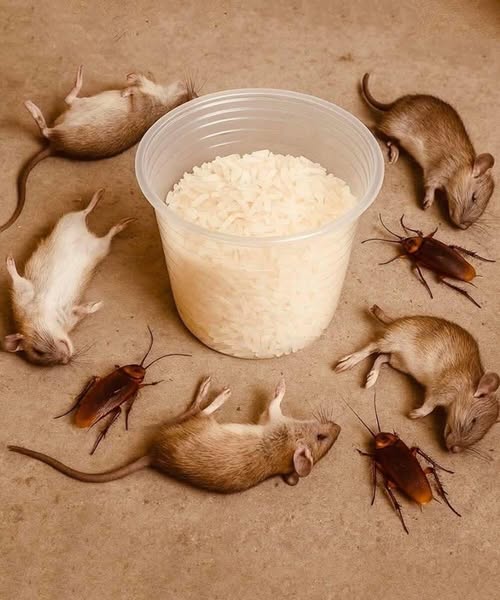
Eliminating pests like rats and cockroaches from your home doesn’t always require harsh chemicals or expensive extermination services.
In fact, many natural, cost-effective solutions are available right in your kitchen pantry—one of the most surprising being plain rice. This everyday staple, when combined with a few additional household ingredients, can become a powerful weapon in your pest control toolkit. These methods are not only effective, but they also reduce the risk of exposing your family and pets to toxic substances commonly found in commercial pesticides.
How Rice Works in Natural Pest Control
Rice is particularly useful in pest control because of its structure and digestibility—or rather, the lack thereof in certain forms. Cooked rice can attract pests like cockroaches due to its soft texture and mild scent, especially when enhanced with other ingredients. Uncooked rice, on the other hand, is harder for pests like rats to digest, especially when mixed with substances that affect their internal systems. The beauty of rice-based remedies lies in their dual role: as bait and as a medium for delivering pest-deterring or pest-eliminating substances.
For Cockroach Control: Cooked Rice, Sugar & Boric Acid
Cockroaches are persistent, unsanitary insects that thrive in warm, humid places like kitchens and bathrooms. A popular natural remedy for controlling them involves mixing cooked rice, boric acid, and sugar:
-
How it works: The sugar draws the cockroaches to the bait. The rice provides texture and bulk, making the bait appealing. The boric acid acts as the lethal agent. When cockroaches consume this mixture, the boric acid disrupts their digestive system and nervous system, leading to death.
-
How to use: Form small pea-sized balls or spoon small portions of the mixture onto pieces of wax paper or in shallow lids. Place these in areas where cockroach activity is high—behind refrigerators, under sinks, and in cabinet corners.
-
Tip: Replace the bait every 3–5 days to ensure freshness and continued effectiveness.
For Rat Control: Uncooked Rice with Plaster of Paris
Rats are clever and cautious pests that can cause serious damage to homes by gnawing on wires, contaminating food, and spreading diseases. A simple but potent method to deal with rats involves combining uncooked rice with plaster of Paris (powdered gypsum):
-
How it works: When rats eat this mixture and then drink water, the plaster reacts inside their digestive system and hardens. This causes internal blockage and eventually leads to a fatal outcome.
-
Recipe: Mix equal parts uncooked rice and powdered plaster. Optionally, add a bit of cocoa powder or sugar to improve the scent and taste.
-
Where to place it: Distribute the mixture in small containers or lids near rat activity zones—behind appliances, near garbage bins, or along baseboards.
-
Caution: Ensure these are completely out of reach of pets and children, as plaster is not safe for accidental ingestion.
Alternative Rat Remedy: Rice, Sugar & Baking Soda
If you don’t have access to plaster of Paris or prefer a gentler method, baking soda is an excellent alternative. When combined with rice and sugar, it creates a gas-producing reaction in rats’ stomachs:
-
How it works: The sugar and rice attract the rats. Once consumed, the baking soda reacts with the acids in their stomach, producing gas. Rats can’t expel gas the way humans can, so the buildup leads to discomfort and can be fatal.
-
Recipe: Mix equal parts uncooked rice, baking soda, and sugar. Use small containers or paper plates to place the bait in quiet, dark corners.
-
Note: This method is slower and may require consistent application over several days to see noticeable results.
Safety Tips for Using Natural Remedies
-
Keep mixtures out of reach of pets and small children by placing them behind furniture, inside cabinets with only small access gaps, or in sealed traps with tiny openings.
-
Label bait areas clearly if you live with others to avoid accidental exposure.
-
Avoid using in open food preparation areas, and clean up any spills immediately.
-
Monitor the areas where you’ve placed the bait regularly. If you notice fewer droppings or sightings, you’re likely seeing results.
-
Dispose of dead pests promptly, as their presence can still pose a health hazard, especially in warmer climates.
Other Complementary Natural Tips
-
Bay leaves and mint oil can be used as rodent repellents. Place dried bay leaves in corners or soak cotton balls in peppermint oil and place them near entry points.
-
Cucumber peels and garlic paste can deter cockroaches naturally.
-
Sealing cracks and gaps, keeping the house clean, and storing food properly are crucial to preventing infestations in the first place.
The Takeaway
Rice-based pest control offers a natural, affordable, and eco-friendly alternative to chemical-laden sprays and traps. With just a few ingredients—most of which are likely already in your kitchen—you can tackle the problem effectively without risking the health of your family or pets. Whether you’re fighting cockroaches in the pantry or rats in the garage, these simple DIY remedies empower you to reclaim your space with confidence and care.
In the end, pest control doesn’t have to be complicated or toxic. Sometimes, all it takes is a little rice and a clever recipe to restore peace in your home.